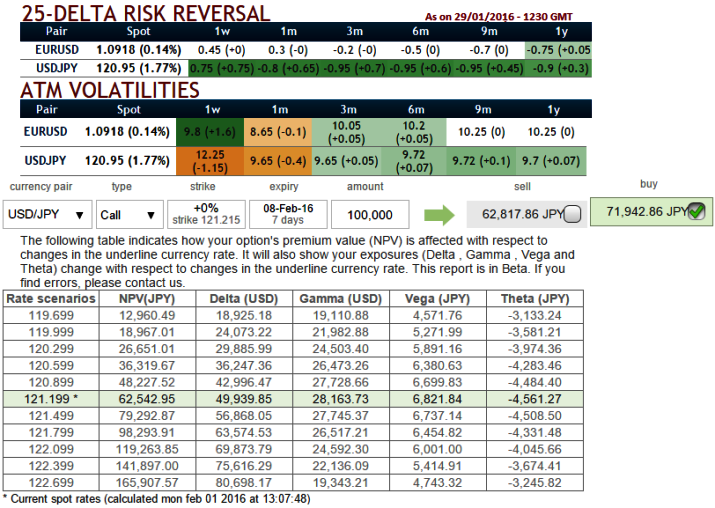Last Friday's, the rate charge by BoJ makes commercial banks that park surplus reserves at the central bank to negative 0.1% in a slightly awful stimulated pointing at serving its economy to cushion the potential threats of deflation.
By pushing rates into negative territory, the BOJ is in effect penalizing commercial banks for not lending aggressively by charging the institutions for holding excessive reserves at the central bank.
Soon after the unanticipated monetary policy decision, major central banks in the world have now begun offering rates in negative territory for the first time ever. The BOJ's unprecedented move follows a similar policy implemented by the European Central Bank in 2014.
The dovish position from the BoJ could influence the Fed to bring in deferral for further tightening measures, as other top global economies continue to show signs of weakness. On Wednesday, the Federal Open Market Committee (FOMC) left its benchmark Fed's funds rate unchanged between 0.25 and 0.50%.
This dovish measure by BoJ has been perceived as fraught effort to boost insistently tepid inflation. While Japan's annual core CPI increased subtly by 0.1% in November, which was the 1st increase in last 5 months. Japanese Core CPI, which strips out fresh food prices, remains significantly below the BOJ's price target.
The BOJ is currently pumping ¥80 trillion into the Japanese economy ($674 million) through a large-scale quantitative easing program that has achieved varying amounts of success over the last three years.
Kuroda cited increased risks pertained to the Chinese economy struggling and EM's slowdown, as well as extensive volatility in global financial markets at the beginning of the year. Kuroda indicated that the BOJ will extend the negative rate policy "as long as necessary."
As such, we discuss some key considerations that relate to economic developments herein, assessing risks ahead of the central bank's policy stance in the months to come and yen's gains against dollar. Please be ntoed that the ATM calls are trading 15% more than NPV which is in line with the OTC market sentiments (no deviation from the delta risk reversals commpuutaion). So shorting such calls using narrrow expiries in the diagonal spreads would likley to derive certain yields.
Keeping all these factors in mind, it is advisable to go long in 1M (1%) OTM 0.16 delta call while writing 2W (1%) ATM call with positive theta and delta closer to zero (both sides use European style options), this bear call spread option trading strategy is recommended when the USDJPY spot FX is anticipated to slump moderately in the near term.
As we can see from the risk reversal table, the OTC market is hinting a slight recovery but long term bear trend may resume sooner, the bear call spread option strategy is also known as the bear call credit spread as a credit is received upon entering the trade.
FxWirePro: BoJ dovish tone likely to defer FOMC’s tightening - USD/JPY’s spike is momentary, speculate with credit call spreads

Monday, February 1, 2016 8:45 AM UTC
Editor's Picks
- Market Data
Most Popular



 FxWirePro: GBP/NZD edges higher but bearish outlook persists
FxWirePro: GBP/NZD edges higher but bearish outlook persists  FxWirePro: EUR/AUD poised for further downside after key fibo break
FxWirePro: EUR/AUD poised for further downside after key fibo break  Yen Storm Hits EURJPY: Crashes Below 181 – Sell the Bounce Intraday! Target 179.50 with Tight Stop Above 181.45
Yen Storm Hits EURJPY: Crashes Below 181 – Sell the Bounce Intraday! Target 179.50 with Tight Stop Above 181.45  FxWirePro: USD/CAD downside pressure builds, key support level in focus
FxWirePro: USD/CAD downside pressure builds, key support level in focus  AUDJPY Eyes New Highs: Bulls Hold 102 Support, Target 104
AUDJPY Eyes New Highs: Bulls Hold 102 Support, Target 104  FxWirePro- Major European Indices
FxWirePro- Major European Indices  FxWirePro: USD/ CNY gains some upside momentum but still bearish
FxWirePro: USD/ CNY gains some upside momentum but still bearish  FxWirePro: EUR/NZD neutral in the near-term, scope for downward resumption
FxWirePro: EUR/NZD neutral in the near-term, scope for downward resumption  FxWirePro: GBP/AUD positions for another drop, eyes 2.0100 level
FxWirePro: GBP/AUD positions for another drop, eyes 2.0100 level  FxWirePro- Major US Indices
FxWirePro- Major US Indices  FxWirePro: GBP/USD hits 5-week,scope for further upside
FxWirePro: GBP/USD hits 5-week,scope for further upside  FxWirePro: AUD/USD consolidates gains ,remains on positive footing
FxWirePro: AUD/USD consolidates gains ,remains on positive footing  FxWirePro: USD/JPY neutral in the near-term, scope for downward resumption
FxWirePro: USD/JPY neutral in the near-term, scope for downward resumption  FxWirePro: NZD/USD sustains gains as uptrend remains strong
FxWirePro: NZD/USD sustains gains as uptrend remains strong  Dollar Crumbles on Dovish Fed Bets – USD/CHF Eyes 0.7865 Next
Dollar Crumbles on Dovish Fed Bets – USD/CHF Eyes 0.7865 Next 



























